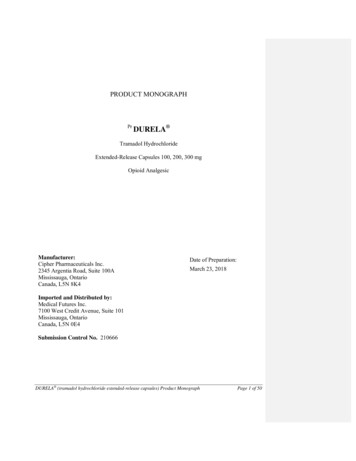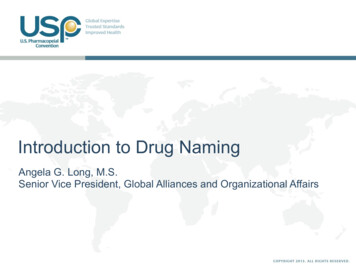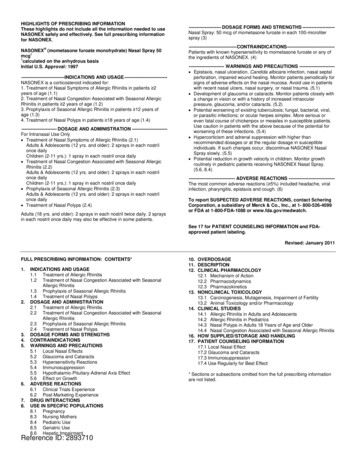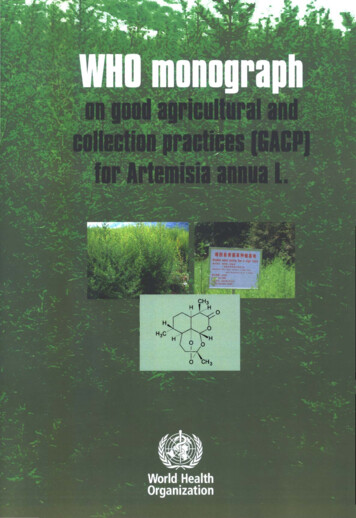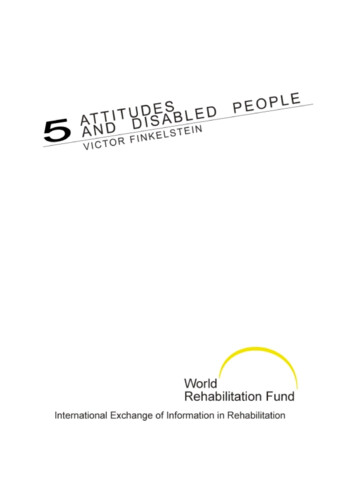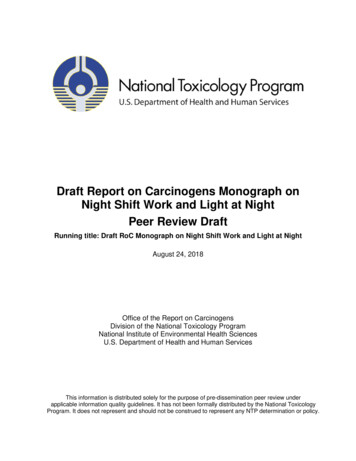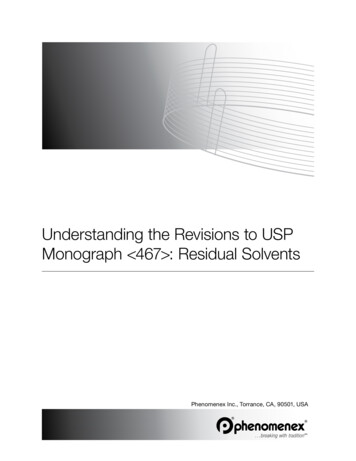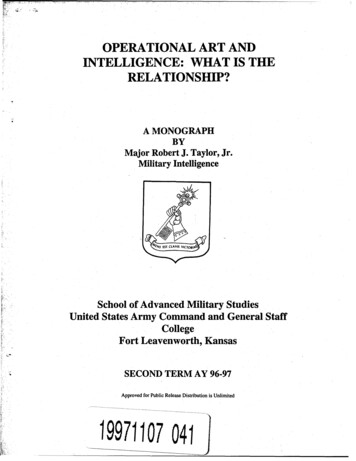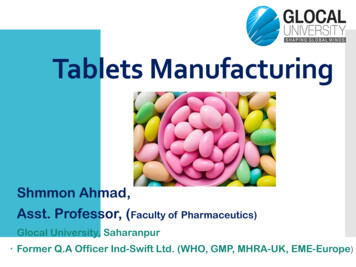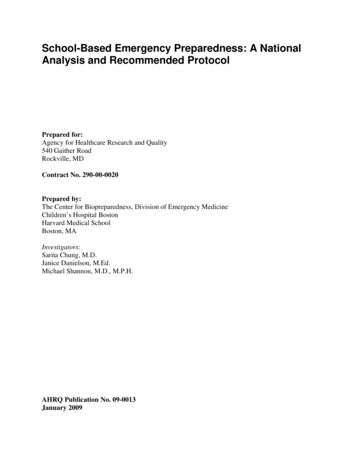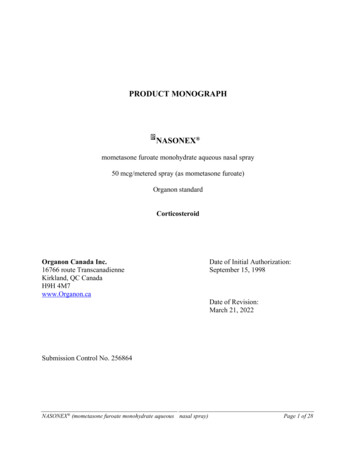
Transcription
PRODUCT MONOGRAPHNASONEX mometasone furoate monohydrate aqueous nasal spray50 mcg/metered spray (as mometasone furoate)Organon standardCorticosteroidOrganon Canada Inc.16766 route TranscanadienneKirkland, QC CanadaH9H 4M7www.Organon.caDate of Initial Authorization:September 15, 1998Date of Revision:March 21, 2022Submission Control No. 256864NASONEX (mometasone furoate monohydrate aqueous nasal spray)Page 1 of 28
RECENT MAJOR LABEL CHANGESINDICATIONSDOSAGE AND ADMINISTRATION02/202202/2022Table of ContentsRECENT MAJOR LABEL CHANGES .2PART I: HEALTH PROFESSIONAL INFORMATION .3SUMMARY PRODUCT INFORMATION .3INDICATIONS .3CONTRAINDICATIONS .4WARNINGS AND PRECAUTIONS .4ADVERSE REACTIONS.6DRUG INTERACTIONS .8DOSAGE AND ADMINISTRATION .8OVERDOSAGE .10ACTION AND CLINICAL PHARMACOLOGY .10STORAGE AND STABILITY .11DOSAGE FORMS, COMPOSITION AND PACKAGING .12PART II: SCIENTIFIC INFORMATION .13PHARMACEUTICAL INFORMATION.13CLINICAL TRIALS .14DETAILED PHARMACOLOGY .19TOXICOLOGY .20REFERENCES .24PART III: CONSUMER INFORMATION.25NASONEX (mometasone furoate monohydrate aqueous nasal spray)Page 2 of 28
PRODUCT MONOGRAPHNASONEX mometasone furoate monohydrate aqueous nasal sprayPART I: HEALTH PROFESSIONAL INFORMATIONSUMMARY PRODUCT INFORMATIONRoute ofAdministrationnasalDosage Form /Strengthsuspension /50 mcg per meteredsprayNonmedicinal Ingredientsbenzalkonium chloride, citric acid, dispersiblecellulose BP 65 cps (carboxymethylcellulosesodium, microcrystalline cellulose), glycerol,Polysorbate 80, purified water, and sodiumcitrate dihydrateINDICATIONSNASONEX (mometasone furoate monohydrate aqueous nasal spray) is indicated for: use in children between the ages of 3 and 11 years to treat the symptoms of seasonal orperennial allergic rhinitis. use in adults and children 12 years of age and older as adjunctive treatment to antibioticsin acute episodes of rhinosinusitis, where signs or symptoms of bacterial infection arepresent. use in adults and children 12 years of age and older in the treatment of symptomsassociated with mild to moderate uncomplicated acute rhinosinusitis where signs orsymptoms of bacterial infection are not present. the treatment of nasal polyps in adult patients 18 years of age or older.NASONEX (mometasone furoate monohydrate aqueous nasal spray)Page 3 of 28
CONTRAINDICATIONSPatients who are hypersensitive to this drug or to any ingredient in the formulation or componentof the container. For a complete listing, see the DOSAGE FORMS, COMPOSITION ANDPACKAGING section of the product monograph.NASONEX should be used with caution, if at all, in patients with active or quiescenttuberculous infections of the respiratory tract, or in untreated fungal, bacterial, systemic viralinfections or ocular herpes simplex.WARNINGS AND PRECAUTIONSGeneralDuring transfer from systemic corticosteroid to NASONEX , some patients may experiencesymptoms of withdrawal from systemically active corticosteroids (e.g., joint and/or muscularpain, lassitude, and depression initially) despite relief from nasal symptoms and will requireencouragement to continue NASONEX therapy. Such transfer may also unmask pre-existingallergic conditions such as allergic conjunctivitis and eczema, previously suppressed by systemiccorticosteroid therapy.Acute RhinosinusitisPatients should not use NASONEX without an antibiotic if bacterial infection of the sinuses ispresent or suspected.NASONEX is not indicated to treat the symptoms of the common cold. To distinguish mild tomoderate acute rhinosinusitis from the common cold, patients should have symptoms of acuterhinosinusitis persisting or increasing for at least seven days before starting NASONEX treatment.If signs or symptoms of severe bacterial infection are observed during treatment (such as fever,persistent severe unilateral facial/tooth pain, orbital or peri-orbital facial swelling, or worseningof symptoms after an initial improvement), the patient should be advised to consult theirphysician immediately at which time the physician may advise the patient to stop usingNASONEX .Safety and efficacy of NASONEX in the treatment of symptoms associated with mild tomoderate uncomplicated acute rhinosinusitis beyond 15 days has not been evaluated.Ear/Nose/ThroatNASONEX should not be used in the presence of untreated localized infection involving thenasal mucosa.Because of the inhibitory effect of corticosteroids on wound healing, patients who have experiencedrecent nasal surgery or trauma should not use a nasal corticosteroid until healing has occurred.NASONEX (mometasone furoate monohydrate aqueous nasal spray)Page 4 of 28
Following 12 months of treatment with NASONEX , there was no evidence of atrophy of thenasal mucosa; also, mometasone furoate tended to reverse the nasal mucosa closer to a normalhistologic phenotype. As with any long-term treatment, patients using NASONEX over severalmonths or longer should be examined periodically for possible changes in the nasal mucosa. Iflocalized fungal infection of the nose or pharynx develops, discontinuance of NASONEX therapy or appropriate treatment may be required. Persistence of nasopharyngeal irritation maybe an indication for discontinuing NASONEX .Following the use of intranasal aerosolized corticosteroids, instances of nasal septum perforationhave been reported very rarely.Endocrine and MetabolismThere is no evidence of hypothalamic-pituitary-adrenal (HPA) axis suppression followingprolonged (12 months) treatment with NASONEX . However, patients who are transferred fromlong-term administration of systemically active corticosteroids to NASONEX require carefulattention. Systemic corticosteroid withdrawal in such patients may result in adrenal insufficiencyfor a number of months until recovery of HPA axis function. If these patients exhibit signs andsymptoms of adrenal insufficiency, systemic corticosteroid administration should be resumedand other modes of therapy and appropriate measures instituted.ImmunePatients receiving corticosteroids who are potentially immunosuppressed should be warned ofthe risk of exposure to certain infections (e.g., chickenpox, measles) and of the importance ofobtaining medical advice if such exposure occurs.OphthalmologicFollowing the use of intranasal aerosolized corticosteroids, instances of increased intraocularpressure have been reported very rarely.Visual disturbance may be reported with systemic and topical (including, intranasal, inhaled andintraocular) corticosteroid use. If a patient presents with symptoms such as blurred vision orother visual disturbances, the patient should be considered for referral to an ophthalmologist forevaluation of possible causes of visual disturbances; this may include cataract, glaucoma or rarediseases such as central serous chorioretinopathy (CSCR) which have been reported after use ofsystemic and topical corticosteroids.Special PopulationsPregnancy and Nursing MothersThere are no adequate or well-controlled studies in pregnant or nursing women.As with other nasal corticosteroid preparations, NASONEX should be used in pregnant women,nursing mothers or women of childbearing age only if the potential benefit justifies the potentialrisk to the mother, fetus, or infant. Infants born of mothers who received corticosteroids duringpregnancy should be observed carefully for hypoadrenalism.NASONEX (mometasone furoate monohydrate aqueous nasal spray)Page 5 of 28
PediatricsNASONEX permitted normal growth in a placebo-controlled clinical trial in which pediatricpatients were administered NASONEX 100 mcg daily for one year.Safety and efficacy of NASONEX as adjunctive treatment to antibiotics in acute episodes ofrhinosinusitis in children less than 12 years of age have not been studied.Safety and efficacy of NASONEX for the treatment of symptoms associated with mild to moderateuncomplicated acute rhinosinusitis in children less than 12 years of age have not been studied.Safety and efficacy of NASONEX for the treatment of nasal polyps in children and adolescentsless than 18 years of age have not been studied.ADVERSE REACTIONSRarely, immediate hypersensitivity reactions (e.g., bronchospasm, dyspnea) may occur afterintranasal administration of mometasone furoate monohydrate. Very rarely, anaphylaxis andangioedema have been reported.Disturbances of taste and smell have been reported very rarely.Clinical Trial Adverse Drug ReactionsBecause clinical trials are conducted under very specific conditions the adverse reaction ratesobserved in the clinical trials may not reflect the rates observed in practice and should not becompared to the rates in the clinical trials of another drug. Adverse drug reaction information fromclinical trials is useful for identifying drug-related adverse events and for approximating rates.Allergic RhinitisAdults and adolescents 12 years of age: Table 1 demonstrates the incidence of treatment relatedadverse reactions associated with NASONEX based upon the pooled data from clinical trials.Table 1: Treatment related adverse reactions occurring at an incidence of 1% and more commonly than placeboAdverse ReactionsHeadacheEpistaxisPharyngitisNASONEX *n 3210n (%)265 (8)267 (8)124 (4)* 50 mcg to 800 mcg of mometasone furoate dailyPlacebon 1671n (%)101 (6)89 (5)58 (3)Treatment-related local adverse events reported in clinical studies, headache, epistaxis (e.g.,frank bleeding, blood-tinged mucus, and blood flecks), pharyngitis, and nasal ulceration areNASONEX (mometasone furoate monohydrate aqueous nasal spray)Page 6 of 28
typically observed with use of a corticosteroid nasal spray. In addition, the following adverseevents occurred at a frequency equal to or less than placebo, nasal burning (2% vs. 3%) and nasalirritation (2% vs. 2%), respectively.Epistaxis was generally self-limiting and mild in severity, and occurred at a higher incidencecompared to placebo (5%), but at a comparable or lower incidence compared to the activecontrol nasal corticosteroids studied (up to 15%). The incidence of all other effects wascomparable with that of placebo.Pediatric patients 3 to 11 years of age: In the pediatric population, the incidence of adverseeffects, e.g. headache (3%), epistaxis (6%), nasal irritation (2%), and sneezing (2%) wascomparable to placebo.Acute Rhinosinusitis as Adjunctive Treatment to AntibioticsIn adults and adolescent patients receiving NASONEX as adjunctive treatment for acuteepisodes of rhinosinusitis, treatment-related adverse events, which occurred at an incidencecomparable to placebo, included headache (2%), pharyngitis (1%), nasal burning (1%), and nasalirritation (1%). Epistaxis was mild in severity and also occurred at an incidence comparable toplacebo (5% vs. 4%, respectively).Mild to Moderate Uncomplicated Acute RhinosinusitisIn patients treated for mild to moderate acute rhinosinusitis, the overall incidence of adverseevents was comparable to placebo and similar to that observed for patients with allergic rhinitis.Nasal PolypsIn patients treated for nasal polyps, the overall incidence of adverse events was comparable toplacebo and similar to that observed for patients with allergic rhinitis.Less Common Clinical Trial Adverse Drug Reactions ( 1%)The following additional treatment related adverse reactions occurred in clinical trials in patientsusing NASONEX with an incidence of 1% and occurred at a greater incidence than placebo*:Blood and lymphatic system disorders: lymphadenopathyCardiac disorders: palpitation, tachycardiaEye disorders: lacrimation, conjunctivitis, dry eyes, abnormal visionEar and labyrinth disorders: earache, tinnitusGastrointestinal disorders: abdominal pain, constipation, diarrhea, gastritis, nausea, tonguedisorder, tooth disorderGeneral disorders and administration site conditions: dry mouth, allergy aggravated, chest pain,edema, face edema, fever, influenza like symptoms, thirst, taste perversionInfections and infestations: cold sore non herpetic, infection, bacterial infectionInvestigations: hepatic enzymes increasedMusculoskeletal and connective tissue disorders: arthralgia, myalgiaNervous system disorders: tremor, vertigo, migrainePsychiatric disorders: depression, paranoia, somnolenceNASONEX (mometasone furoate monohydrate aqueous nasal spray)Page 7 of 28
Respiratory, thoracic and mediastinal disorders: dysphonia, bronchitis, dyspnea, laryngitis,nasal septum ulceration, sinusitis, wheezingSkin and subcutaneous tissue disorders: acne, dermatitis, erythematous rashVascular disorders: hypertension*Events reported by more than 1 patientPost-Market Adverse Drug ReactionsThe following adverse reactions have been identified during the post-marketing period forNASONEX : anaphylaxis and angioedema, disturbances in smell and nasal septal perforation,vision blurred. Because these reactions are reported voluntarily from a population of uncertainsize, it is not always possible to reliably estimate their frequency or establish a causalrelationship to drug exposure.DRUG INTERACTIONSDrug-Drug InteractionsNASONEX has been administered concomitantly with loratadine with no apparent effect onplasma concentrations of loratadine or its major metabolite. In these studies, mometasone furoateplasma concentrations were not detectable using an assay with a LLOQ of 50 pg/mL. Thecombination therapy was well tolerated.Inhibitors of Cytochrome P450 3A4: Studies have shown that mometasone furoate is primarilyand extensively metabolized in the liver of all species investigated and undergoes extensivemetabolism to multiple metabolites. Mometasone furoate is metabolized by CYP3A4. After oraladministration of ketoconazole, a strong inhibitor of CYP3A4, the mean plasma concentration oforally inhaled mometasone furoate increased, and plasma cortisol levels appeared to decrease.Co-treatment with CYP3A inhibitors (e.g., ketoconazole, itraconazole, clarithromycin,atazanavir, indinavir, nelfinavir, saquinavir, ritonavir, cobicistat-containing products), isexpected to increase the risk of systemic side-effects. The combination should be avoided unlessthe benefit outweighs the increased risk of systemic corticosteroid side-effects, in which casepatients should be monitored for systemic corticosteroid side-effects.DOSAGE AND ADMINISTRATIONDosing ConsiderationsThe therapeutic effects of corticosteroids, unlike those of decongestants, are not immediate.Since the effect of NASONEX depends on its regular use, patients should be instructed to takethe nasal inhalation at regular intervals and not, as with other nasal sprays, as they feel necessary.NASONEX (mometasone furoate monohydrate aqueous nasal spray)Page 8 of 28
In the presence of excessive nasal mucous secretion or edema of the nasal mucosa, the drug mayfail to reach the site of action. In such cases, it is advisable to use a nasal vasoconstrictor for 2 to3 days prior to starting treatment with NASONEX .Recommended Dose and Dosage AdjustmentTreatment of seasonal or perennial allergic rhinitis:Children between the ages of 3 and 11 years: The usual recommended dose is one spray(50 mcg/spray) in each nostril once daily (total daily dose of 100 mcg).Administration to young children should be aided by an adult.Clinically significant onset of action occurs as early as 12 hours after the first dose.Adjunctive treatment to antibiotics in acute episodes of rhinosinusitis:NASONEX should not be used in the presence of untreated localized infection involving thenasal mucosa.Adults (including geriatric patients) and children 12 years of age and older: The usualrecommended dose is two sprays (50 mcg/spray) in each nostril twice daily (total daily dose of400 mcg).If symptoms are inadequately controlled, the dose may be increased to four sprays(50 mcg/spray) in each nostril twice daily (total daily dose of 800 mcg).Treatment of mild to moderate uncomplicated acute rhinosinusitisPatients should not use NASONEX without an antibiotic if bacterial infection of the sinuses ispresent or suspected.Adults (including geriatric patients) and children 12 years of age and older: The usualrecommended dose is two sprays (50 mcg/spray) in each nostril twice daily (total daily dose of400 mcg).If signs or symptoms of severe bacterial infection are observed during treatment (such as fever,persistent severe unilateral facial/tooth pain, orbital or peri-orbital facial swelling, or worsening ofsymptoms after an initial improvement), the patient should be advised to consult their physicianimmediately, at which time the physician may advise the patient to stop using NASONEX .Safety and efficacy of NASONEX in the treatment of symptoms associated with mild tomoderate uncomplicated acute rhinosinusitis beyond 15 days have not been evaluated.Treatment of Nasal PolypsAdults (including geriatric patients) and adolescents 18 years of age and older: The usualrecommended dose is two sprays (50 mcg/spray) in each nostril twice daily (total daily dose of400 mcg).NASONEX (mometasone furoate monohydrate aqueous nasal spray)Page 9 of 28
Once the symptoms are controlled, dose reduction to two sprays (50 mcg/spray) in each nostrilonce daily (total daily dose 200 mcg) may be effective for continued treatment.Efficacy and safety studies of NASONEX for the treatment of nasal polyps were four months induration.AdministrationEach actuation delivers approximately 100 mg of mometasone furoate suspension, containingmometasone furoate monohydrate equivalent up to 50 mcg mometasone furoate. Prior toadministration, NASONEX nasal pump should be primed by actuating the pump 10 times (untila uniform spray is observed). If the spray pump has not been used for 14 days or longer, itshould be reprimed with 2 actuations, until a uniform spray is observed, before next use.SHAKE CONTAINER WELL BEFORE EACH USE.Patients should be instructed on the correct method of use, which is to blow the nose, then insertthe nozzle carefully into the nostril, compress the opposite nostril and actuate the spray whileinspiring through the nose, with the mouth closed.OVERDOSAGEBecause the systemic bioavailability is 1% (using a sensitive assay with a lower quantitationlimit of 0.25 pg/mL) after administration of mometasone furoate via NASONEX , overdose isunlikely to require any therapy other than observation, followed by initiation of the appropriateprescribed dosage.For management of suspected drug overdose, contact your regional Poison Control Centre.ACTION AND CLINICAL PHARMACOLOGYMechanism of ActionMometasone furoate is a topical glucocorticosteroid with local anti-inflammatory properties atdoses that are minimally systemically active.PharmacodynamicsIn two clinical studies utilizing nasal antigen challenge, NASONEX (mometasone furoatemonohydrate aqueous nasal spray) has shown anti-inflammatory activity in both the early- andlate-phase allergic responses. This has been demonstrated by decreases (vs. placebo) in histamineand eosinophil activity and reductions (vs. baseline) in eosinophils, neutrophils, and epithelialcell adhesion proteins. The clinical significance of these finding is not known.Two Phase I studies conducted to assess the systemic exposure and tolerability of NASONEX in children aged 3 to 12 years showed no clinically relevant systemic exposure to NASONEX NASONEX (mometasone furoate monohydrate aqueous nasal spray)Page 10 of 28
and indicated that NASONEX was well tolerated. A third Phase I study in children aged 6 to12 years showed normal short-term lower leg growth velocity.The results of Phase II and Phase III studies indicated no evidence of HPA (hypothalamicpituitary-adrenal) axis suppression following treatment with NASONEX and demonstrated thatNASONEX can alleviate the allergic symptoms in pediatric patients aged 3 to 12 years withseasonal and perennial allergic rhinitis.PharmacokineticsAbsorption:Mometasone furoate monohydrate, administered as a nasal spray, has a systemic bioavailabilityof 1% in plasma, using a sensitive assay with a lower quantitation limit (LLOQ) of 0.25 pg/mL.Mometasone furoate suspension is very poorly absorbed from the gastrointestinal tract, and thesmall amount that may be swallowed and absorbed undergoes extensive first-pass metabolismprior to excretion in urine and bile.Distribution:The in vitro protein binding for mometasone furoate was reported to be 98% to 99% inconcentration range of 5 to 500 ng/mL.Metabolism:Studies have shown that any portion of a mometasone furoate dose which is swallowed andabsorbed undergoes extensive metabolism to multiple metabolites. There are no majormetabolites detectable in plasma. Upon in vitro incubation, one of the minor metabolites formedis 6ß-hydroxymometasonefuroate. In human liver microsomes, the formation of the metabolite isregulated by cytochrome P-450 3A4 (CYP3A4).Elimination:Following intravenous administration, the effective plasma elimination half-life of mometasonefuroate is 5.8 hours. Any absorbed drug is excreted as metabolites mostly via the bile, and to alimited extent, into the urine.STORAGE AND STABILITYNASONEX should be stored between 2 and 25 C and protected from light. Do not freeze.NASONEX (mometasone furoate monohydrate aqueous nasal spray)Page 11 of 28
DOSAGE FORMS, COMPOSITION AND PACKAGINGDosage FormsNASONEX is formulated as an aqueous nasal suspension for nasal administration via ametered-dose manual pump spray delivering 140 doses of 50 mcg mometasone furoate.CompositionEach actuation delivers approximately 100 mg of mometasone furoate suspension, containingmometasone furoate monohydrate equivalent to 50 mcg mometasone furoate.The nonmedicinal ingredients include benzalkonium chloride, citric acid, dispersible celluloseBP 65 cps (carboxymethylcellulose sodium, microcrystalline cellulose), glycerol,Polysorbate 80, purified water, and sodium citrate dihydrate.PackagingNASONEX is supplied in a single pack (1 bottle).NASONEX (mometasone furoate monohydrate aqueous nasal spray)Page 12 of 28
PART II: SCIENTIFIC INFORMATIONPHARMACEUTICAL INFORMATIONDrug SubstanceProper Name:Mometasone furoate monohydrateChemical �-hydroxy-16αmethylpregna-1,4-diene-3,20-dione monohydrateStructural Formula:Molecular Formula: C27H30Cl2O6 . H2OMolecular Weight:539.45Description:Physical form:White to off-white powderSolubility:Mometasone furoate monohydrate is practically insoluble in water(0.02 mg/mL). It is slightly soluble (4–8 mg/mL) in methanol, ethanol,and isopropanol. It is soluble (59–74 mg/mL) in acetone and chloroform,and freely soluble ( 100 mg/mL) in tetrahydrofuran.NASONEX (mometasone furoate monohydrate aqueous nasal spray)Page 13 of 28
CLINICAL TRIALSTreatment of allergic rhinitisSeasonal allergic rhinitis in adolescents and adultsThe safety and efficacy of NASONEX in the treatment of patients with seasonal allergic rhinitis(aged 12 years and over) was investigated in six clinical trials. Altogether, these trials enrolled atotal of 2544 patients of whom 718 were randomized to treatment with NASONEX 200 mcgonce daily.The results of three phase III clinical trials (14- or 28-day studies) with a total of 788 patientswho received NASONEX or placebo and evaluated for efficacy are presented in Table 2. Theprimary efficacy endpoint was the change from baseline in Physician-Evaluated Total NasalSymptom Score (TNSS) after one week of therapy in Study I92-200. In studies C93-013 andI94-001, the primary efficacy endpoint was the change from baseline in Patient-Evaluated TotalNasal Symptom Score over Days 1–15.Table 2: Effect of NASONEX in Phase III, Randomized, Placebo-Controlled Trials in patients with SARNASONEX 100 mcg ODNTNSS1 – BaselineTNSS1 – Change fromBaseline to Day 8 (%)3TNSS2 – BaselineTNSS2 – Change fromBaseline over Days 1–15(%)3122120NASONEX 200 mcg ODMeanNStudy I92-2008.1122-4.3*120(-53%)Study .0-2.6(-34%)7.6-2.3*(-25%)1161167.6-1.5(-17%)Study I94-001TNSS2 – Baseline1047.41037.3TNSS2 – Change from104-2.8*103-0.9Baseline over Days 1–15(-35%)(-10%)(%)3* P 0.01 vs. placebo.1Physician-Evaluated Total Nasal Symptom Score (TNSS). Total of individual nasal symptomscombined (rhinorrhea, nasal stuffiness/congestion, nasal itching and sneezing). Symptoms werescored according to the following rating system; 0 none, 1 mild, 2 moderate, 3 severe.2Patient-Evaluated Total Nasal Symptom Score (TNSS). Total of individual nasal symptomscombined (rhinorrhea, nasal stuffiness/congestion, nasal itching and sneezing). Symptoms werescored according to the following rating system; 0 none, 1 mild, 2 moderate, 3 severe.3Percent change is the difference between post treatment mean score and baseline mean scoredivided by Baseline mean score, multiplied by 100.NASONEX (mometasone furoate monohydrate aqueous nasal spray)Page 14 of 28
Perennial allergic rhinitis in adolescents and adultsThe safety and efficacy of NASONEX in the treatment of patients (aged 12 and over) withperennial allergic rhinitis (PAR) was investigated in three phase III clinical trials of 12-weekduration in 875 patients who received NASONEX or placebo and evaluated for efficacy.The primary efficacy endpoint was the change from baseline in Patient-Evaluated Total NasalSymptom Score (TNSS) from Days 1 to 15. Results of these studies are presented in Table 3.Table 3: Patient-Evaluated Total Nasal Symptom Score1 (TNSS) Results of Trials in Patients with PARPrimary Endpoint(s)NASONEX 200 mcg ODNMeanPlaceboNMeanBaselineChange from baseline overDays 1–15 (%)2160160Study C92-2806.6-1.5* (-21%)1601586.9-1.0 (-13%)BaselineChange from baseline overDays 1–15 (%)2129127Study I92-2936.3-1.7* (-25%)1241216.2-1.2 (-15%)Study I94-079Baseline1546.11486.0Change from baseline over154-2.2** (-37%)148-1.3 (-22%)Days 1–15 (%)2* P 0.01 vs. placebo; ** P 0.01 vs. placebo.1Total of individual nasal symptoms combined (rhinorrhea, nasal stuffiness, nasal itching and sneezing). Symptomswere scored according to the following rating system; 0 none, 1 mild, 2 moderate, 3 severe.2Percent change is the difference between post treatment mean score and baseline mean score divided by Baselinemean score, multiplied by 100.Seasonal and Perennial allergic rhinitis in pediatric patientsThe safety and efficacy of NASONEX in the treatment of pediatric patients with SAR and PARwas investigated in two clinical trials in 645 pediatric patients ranging from age 3 to 11 whoreceived NASONEX or placebo and evaluated for efficacy. Patients were treated for 4 weeks inboth the SAR study and PAR study. In the SAR study, the primary efficacy endpoint was themean change from baseline in the physician-evaluated Total Nasal Symptom Score (TNSS) atDay 8. In the PAR study, the primary efficacy endpoint was the mean change from baseline inphysician-evaluated TNSS at Day 15. Results from these studies are shown in Table 4.NASONEX (mometasone furoate monohydrate aqueous nasal spray)Page 15 of 28
Table 4: Physician-Evaluated Total Nasal Symptom Score1 (TNSS) Results of Trials in Pediatric Patients withAllergic RhinitisPrimary Endpoint(s)NASONEX 100 mcg ODNNMeanStudy C95-161 SAR1358.11348.0Change from Baseline toDay 8 (%)2134-2.8* (-34%)130-1.9 (-24%)Baseline186Study I96-090 PAR6.81906.8BaselineMeanPlaceboChange from Baseline to185-2.8** (-39%)188-2.2 (-32%)Day 15 (%)2* P 0.01 vs. placebo; ** P 0.02 vs. placebo.1Total of individual nasal symptoms combined (rhinorrhea, stuffiness, nasal itching and sneezing). Symptoms werescored according to the following rating system; 0 none, 1 mild, 2 moderate, 3 severe.2Percent change is the difference between post treatment mean score and baseline mean score divided by Baselinemean score, multiplied by 100.Treatment of mild to moderate uncomplicated acute rhinosinusitisIn two clinical trials with 1954 patients 12 years of age and older with mild to moderateuncomplicated acute rhinosinusitis, NASONEX 200 mcg twice daily was effective insignificantly improving symptoms of acute rhinosinusitis compared to placebo as evaluated bythe Major Symptom Score (MSS) composite of symptoms (facial pain/pressure/tenderness, sinusheadache, rhinorrhea, post nasal drip, and nasal
NASONEX (mometasone furoate monohydrate aqueous nasal spray) Page 5 of 28 Following 12 months of treatment with NASONEX , there was no evidence of atrophy of the nasal mucosa; also, mometasone furoate tended to reverse the nasal mucosa closer to a normal histologic phenotype. As with any long-term treatment, patients using NASONEX over .
